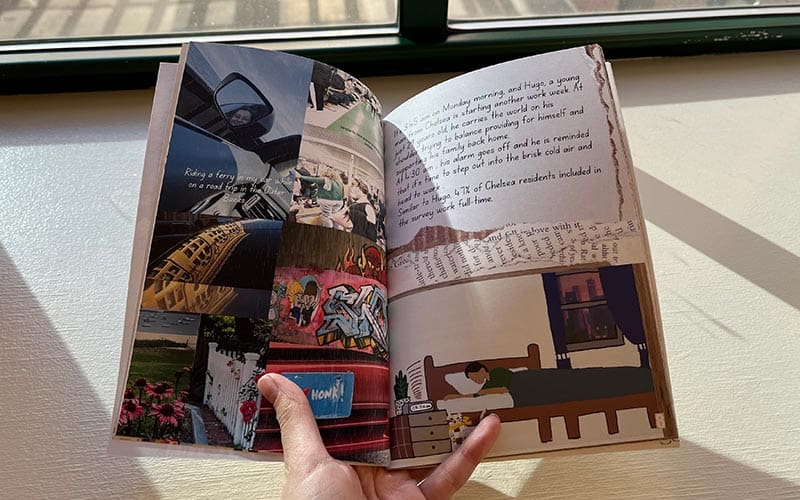
"Chelsea Chronicles: Navigating Life and Transit" offers snapshots of how Chelsea residents live, work, and move around their community.
If you peruse the “Chelsea Chronicles: Navigating Life and Transit” zine, you’ll meet a diverse cross-section of Chelsea residents. “Hugo” rises at 4:30 a.m. to take the bus to the first of his two low-paid jobs, which he uses to support his family back home. “Minoo” gets creative to put meals on the table for her young family. “Stephanie” works hard so she can afford rent and holiday presents for her son.
These characters aren’t real, but the people they represent are. According to a survey conducted by the Healthy Neighborhoods Study, dedicated to improving the health of Massachusetts communities, 11% of Chelsea residents must work extra hours to make ends meet, 16% sometimes go hungry, and 38% receive government housing assistance.
The study was designed and implemented alongside resident researchers in nine partnering cities, with support from CLF, MIT, and the Robert Wood Johnson Foundation. It uncovered key information about community members’ financial security, food insecurity, housing needs, and other indicators of community health. When Ruth Alcantara, a fellow with the environmental justice nonprofit GreenRoots and site coordinator for the study, reviewed the study’s results in Chelsea, she knew a research report was not the right format to share this vital information with community members.
“I thought, ‘Let’s share this knowledge with the community it was collected from in a way that they will understand and resonate with,’” says Alcantara. “There are so many reports and papers. Do something different!”
Alcantara and Greenroots decided to repackage the information as a zine, highlighting key points from the study via fictionalized, illustrated narratives featuring relatable characters like “Hugo” and “Minoo.” The zine features these stories alongside other artistic submissions, including poems and comics, from the public. Alcantara partnered with resident researcher Mitikei Chengerei, who also represents GreenRoots, and HNS research associate Shinelle Kirk.
Turning data into art
Chengerei took the lead in writing stories featuring important takeaways from the wide-ranging survey. She says she drew inspiration from her own life. Alcantara brought the vignettes to life with illustrations.
This creative approach was part of a strategy to make the study’s data accessible to people in the community. Many Chelsea residents could benefit from sharing common needs and challenges, but few have the time to sift through academic research. Turning facts into art builds an important conduit between information and the people who need it the most.
“You can be creative and showcase data, showcase knowledge in a different way that is outside the norm, and I hope the zine inspires other people to do it, too,” Alcantara says.
The survey paints a picture of Chelsea as a city of striving immigrants, young parents, and retirees struggling with high rents and stagnant pay, leading to gentrification and displacement. The narratives featured in the zine represent real people fighting to remain in their homes. The study found that more than one-third of all Chelsea residents suffer financial hardship due to housing costs. The struggle is especially acute for respondents with children. Faltering public transit has a particularly negative impact on people who can’t afford a car or need to navigate to multiple jobs, schools, and childcare facilities. Unsurprisingly, almost a third of those surveyed report feeling downhearted recently. Nonetheless, Chelsea residents are dedicated to their homes and want their city to thrive.
CLF’s Kirk says her hope for the zine “is that people learn more about [gentrification], people understand what’s happening in Chelsea and these large minority communities with people getting pushed out.”
Amplifying community voices
In addition to producing their own stories and illustrations, the Healthy Neighborhoods Study researchers solicited submissions from others passionate about Chelsea. Alcantara and Chengerei distributed bilingual flyers door-to-door, recruited friends and colleagues, and posted posters at local libraries. Initially, Alcantara envisioned the zine focusing on the role of public transportation in Chelsea. As submissions came flooding in from across the city, she realized that people wanted to discuss many challenges affecting their neighborhood, and the zine’s focus expanded.
The submissions were as creative and diverse as the residents of Chelsea themselves. Two climate advocates created a comic featuring a fly attempting to ride the Orange Line subway to playfully discuss the possibility of fare-free public transit. A screenwriter submitted an introduction to his film script about a young woman’s evolution as a transportation activist. A writer penned a poem about the unexpected connections that teens discovered between a tree-planting project and their own queer identities. Two transit activists collaborated on another poem about the intersections between environmental injustice and other threats facing Chelsea residents. Many people shared photos from their transportation experiences, assembled into colorful collages.
Sharing the zine far and wide
Once they finalized the zine, the team began the hard work of distributing it. Every contributor received a free copy. Barbara Espinosa and Jacqueline Segovia, who connected to the project through GreenRoots, translated the zine into Spanish – crucial in a community where most residents identify as Hispanic or Latinx. Alcantara coordinated the publishing of the zine online and promoted it on social media to increase its reach.
The team is still working hard to share the zine more widely, but the early responses have all been positive. The zine has given Chelsea’s residents, activists, and grassroots organizations a valuable tool to strengthen and empower their community.
Says Chengerei: “I think if some people see this zine … they will think that survey is giving [them a] voice, that their voice will be heard.”



